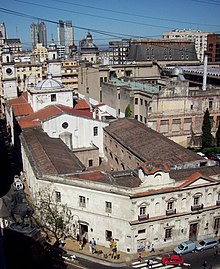Illuminated Block



The Illuminated Block (Spanish: Manzana de las Luces) is a historical landmark in the Monserrat neighbourhood of Buenos Aires, Argentina.
History
The
The 1767 suppression of the Society of Jesus led to the mission's closure, however, as well as an associated one housing a hospital, in the nearby San Telmo district. The academy was closed only temporarily, and was converted in 1772 into the Royal College of San Carlos. The temple was usurped and converted into a cathedral in 1775, though Father Falkner's pharmacy formed the basis for Viceroy Juan José de Vértiz's Medical Court of 1780 - the first school of medicine in what is today Argentina.[2] Viceroy Vértiz also established the city's first printing press at the site, in 1780, as well as an orphanage funded by sales of the facility's printed material.[1]
The center later had an anecdotal role in the Argentine War of Independence. The Regiment of Patricians was briefly headquartered in 1811 at the college, where the regiment staged a failed mutiny against their commander, General Manuel Belgrano. A network of five tunnels intersecting under the former mission (believed to have been built to guarantee the flow of supplies in the event of a siege, and to facilitate smuggling in peacetime) helped safeguard ammunitions during much of the war.[1] The provisional government organized from the May Revolution of 1810, the First Assembly, opened a public library in 1812, and following the War of Independence, Governor Martín Rodríguez inaugurated the University of Buenos Aires and the General Archive, in 1821. A few days later, the city's leading newspaper, El Argos, described the area as the "Illuminated Block" in a September 1, 1821, editorial.[3]
Governor Rodríguez also established the Provincial Legislature and the
The Provincial Legislature was used as the
The Illuminated Block was declared a National Historic Monument, in 1942, and was (with three of the catacombs) extensively restored, in 1983.[1]
See also
References
- ^ a b c d "Argentina Tourism: Illuminated Block". Archived from the original on 2009-10-25. Retrieved 2009-07-23.
- ^ University of Buenos Aires School of Medicine: History (in Spanish)
- ^ a b c Historical Dictionary of Argentina. London: Scarecrow Press, 1978.
